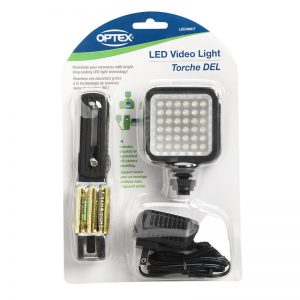
If you’re curious about external lighting but don’t want to spend hundreds of dollars, less expensive LED systems like this one from Optex are a good place to start.
Let’s start with the obvious: fall is not summer. It starts getting darker, sooner. Skies tend to be more cloudy. The food you eat in fall is usually different as well. And you certainly don’t dress the same for fall as you do for summer. So why, may I ask, are you taking pictures in fall the exact same way you took them in summer?
Part of being a strong, well-rounded photographer is adjusting your techniques and tools to get the most out of your shots in any season. As mentioned, days are shorter in fall so there’s less natural light to work with, plus it gets colder so we tend to do more things indoors. Such circumstances often result in dimmer, more gloomy-looking photos, which is why it’s up to you to light your shots with external lighting such as a flash.
People of the smartphone camera—take note: flash photography is not exclusively the domain of the DSLR. These days most people take most of their pictures with a smartphone camera—and this may be the case with you as well—so it’s arguably even more necessary to get the lighting right. Yet as they continue to dominate modern photography, there are more and more lighting apps and devices created especially for smartphones. Ztylus even makes a 12-LED ring light attachment for the iPhone complete with three diffusers. It connects via the ZIP phone case, as does the RV-2 Revolver lens system (each sold separately).
In fact, as ultra-high quality photography gets more and more compact, it is only logical that the accessories would eventually follow suit. The Knog Qudos LED Light Kit can light your GoPro shots with 400 lumens of light from its three powerful Cree LEDs. Weighing just 150 grams, it won’t slow you down as you capture your extreme, active lifestyle. Oh, and it’s also available in black.
As with any camera technique, the secret to beautifully lit photos is practice and experimentation. If you’re a complete beginner, start by getting familiar with your camera’s built-in flash. As you get more comfortable (and more skilled) using it, you may want to invest in an external flash unit. And once you get handy with an external flash, that’s when you’ll find yourself consistently taking photos that are, as they say, ‘professional grade.’
Of course there are a number of helpful resources you can use as a starting point, beginning here at the Photoblog:
And in case you also want to look elsewhere for instructional/educational information:
- ExposureGuide.com
- WhatDigitalCamera.com
Once you enter the realm of flash photography, there are a whole range of adaptations you can pursue: macro ring, hammerhead, studio—the only limits are the time and money you wish to invest. Naturally, we here at the Photoblog recommend stopping by your local London Drugs Photolab to speak with an expert and check out their impressive selection.

